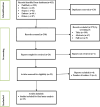Prevalence of meropenem-resistant Pseudomonas Aeruginosa in Ethiopia: a systematic review and meta‑analysis
- PMID: 38600535
- PMCID: PMC11005134
- DOI: 10.1186/s13756-024-01389-2
Prevalence of meropenem-resistant Pseudomonas Aeruginosa in Ethiopia: a systematic review and meta‑analysis
Abstract
Introduction: Antimicrobial resistance (AMR) is a pressing global health concern, particularly pronounced in low-resource settings. In Ethiopia, the escalating prevalence of carbapenem-resistant Pseudomonas aeruginosa (P. aeruginosa) poses a substantial threat to public health.
Methods: A comprehensive search of databases, including PubMed, Scopus, Embase, Hinari, and Google Scholar, identified relevant studies. Inclusion criteria encompassed observational studies reporting the prevalence of meropenem-resistant P. aeruginosa in Ethiopia. Quality assessment utilized JBI checklists. A random-effects meta-analysis pooled data on study characteristics and prevalence estimates, with subsequent subgroup and sensitivity analyses. Publication bias was assessed graphically and statistically.
Results: Out of 433 studies, nineteen, comprising a total sample of 11,131, met inclusion criteria. The pooled prevalence of meropenem-resistant P. aeruginosa was 15% (95% CI: 10-21%). Significant heterogeneity (I2 = 83.6%) was observed, with the number of P. aeruginosa isolates identified as the primary source of heterogeneity (p = 0.127). Subgroup analysis by infection source revealed a higher prevalence in hospital-acquired infections (28%, 95% CI: 10, 46) compared to community settings (6%, 95% CI: 2, 11). Geographic based subgroup analysis indicated the highest prevalence in the Amhara region (23%, 95% CI: 8, 38), followed by Addis Ababa (21%, 95% CI: 11, 32), and lower prevalence in the Oromia region (7%, 95% CI: 4, 19). Wound samples exhibited the highest resistance (25%, 95% CI: 25, 78), while sputum samples showed the lowest prevalence. Publication bias, identified through funnel plot examination and Egger's regression test (p < 0.001), execution of trim and fill analysis resulted in an adjusted pooled prevalence of (3.7%, 95% CI: 2.3, 9.6).
Conclusion: The noteworthy prevalence of meropenem resistance among P. aeruginosa isolates in Ethiopia, particularly in healthcare settings, underscores the urgency of implementing strict infection control practices and antibiotic stewardship. Further research is imperative to address and mitigate the challenges posed by antimicrobial resistance in the country.
Keywords: Ethiopia; Meropenem Resistant; Meta-analysis; Pseudomonas Aeruginosa; Systematic review.
© 2024. The Author(s).
Conflict of interest statement
The authors declare no competing interests.
Figures






Similar articles
-
Antimicrobial resistance profile of Pseudomonas aeruginosa clinical isolates from healthcare-associated infections in Ethiopia: A systematic review and meta-analysis.PLoS One. 2024 Aug 13;19(8):e0308946. doi: 10.1371/journal.pone.0308946. eCollection 2024. PLoS One. 2024. PMID: 39137234 Free PMC article.
-
Prevalence of phenotypic drug resistance profiles and multi-drug-resistant Pseudomonas and Acinetobacter species recovered from clinical specimens in Ethiopia: a systematic review and meta-analysis.BMC Infect Dis. 2025 May 23;25(1):737. doi: 10.1186/s12879-025-11136-6. BMC Infect Dis. 2025. PMID: 40410730 Free PMC article.
-
Antimicrobial resistance pattern of Acinetobacter baumannii clinical isolate in Ethiopia. A systematic review and meta-analysis.BMC Infect Dis. 2025 Apr 12;25(1):518. doi: 10.1186/s12879-025-10923-5. BMC Infect Dis. 2025. PMID: 40221655 Free PMC article.
-
Prevalence and drug resistance patterns of Gram-negative enteric bacterial pathogens from diarrheic patients in Ethiopia: A systematic review and meta-analysis.PLoS One. 2022 Mar 16;17(3):e0265271. doi: 10.1371/journal.pone.0265271. eCollection 2022. PLoS One. 2022. PMID: 35294487 Free PMC article.
-
Prevalence of Vancomycin resistant enterococci (VRE) in Ethiopia: a systematic review and meta-analysis.BMC Infect Dis. 2020 Feb 11;20(1):124. doi: 10.1186/s12879-020-4833-2. BMC Infect Dis. 2020. PMID: 32046668 Free PMC article.
Cited by
-
Antioxidant and Antibacterial Activities Evaluation, Phytochemical Characterisation of Rhizome from Angiopteris helferiana and Barks from Saurauia fasciculata in Nepal.ScientificWorldJournal. 2024 Jun 12;2024:1119165. doi: 10.1155/2024/1119165. eCollection 2024. ScientificWorldJournal. 2024. PMID: 38898935 Free PMC article.
-
Construction and validation of a meropenem-induced liver injury risk prediction model: a multicenter case-control study.Front Pharmacol. 2025 May 9;16:1542554. doi: 10.3389/fphar.2025.1542554. eCollection 2025. Front Pharmacol. 2025. PMID: 40417215 Free PMC article.
-
Trends and patterns of antimicrobial resistance among common pathogens isolated from adult bloodstream and urinary tract infections in public health facilities in Malawi, 2020-2024.BMC Infect Dis. 2025 Jul 26;25(1):946. doi: 10.1186/s12879-025-11335-1. BMC Infect Dis. 2025. PMID: 40713498 Free PMC article.
-
Global prevalence and antibiotic resistance profiles of carbapenem-resistant Pseudomonas aeruginosa reported from 2014 to 2024: a systematic review and meta-analysis.Front Microbiol. 2025 Jul 21;16:1599070. doi: 10.3389/fmicb.2025.1599070. eCollection 2025. Front Microbiol. 2025. PMID: 40761277 Free PMC article.
-
Optimization of meropenem dosing regimens in critically ill patients with augmented renal clearance.Front Med (Lausanne). 2025 May 9;12:1550053. doi: 10.3389/fmed.2025.1550053. eCollection 2025. Front Med (Lausanne). 2025. PMID: 40417688 Free PMC article.
References
-
- World Health Organization. Antimicrobial Resistance in the WHO African Region: a systematic literature review. Antimicrobial resistance in the WHO African Region: a systematic literature review. 2021.
-
- Pier GB. 314 - Pseudomonas and related gram-negative Bacillary infections. In: Goldman L, Schafer AI, editors. Goldman’s Cecil Medicine (Twenty Fourth Edition) Philadelphia: W.B. Saunders; 2012. pp. 1877–81.
Publication types
MeSH terms
Substances
LinkOut - more resources
Full Text Sources
Miscellaneous

